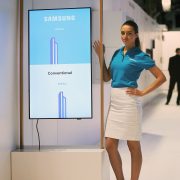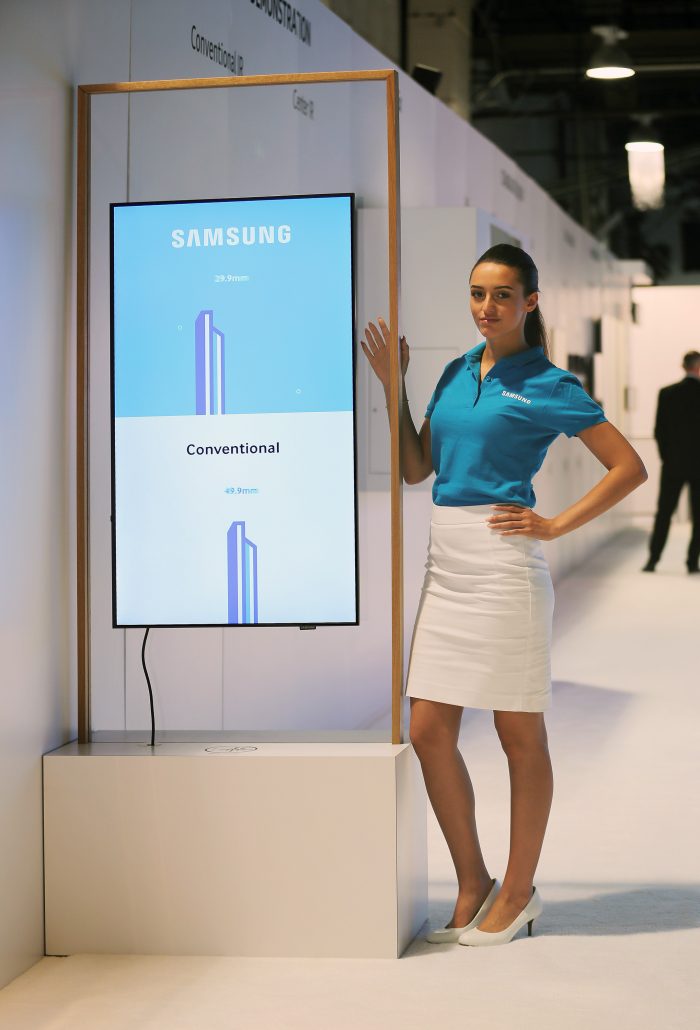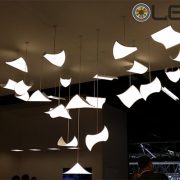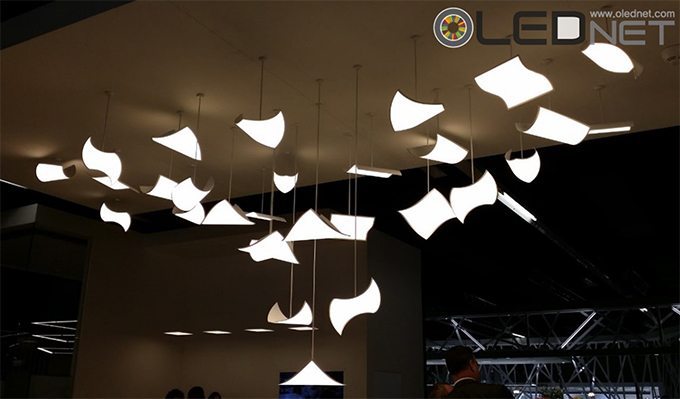Samsung Brings Tizen OS to Smart Signage Portfolio

Tigen OS Equipped Smart Signage (Source = Samsung)
Hyunjoo Kang / jjoo@olednet.com
Samsung Electronics, will showcase the latest additions to its industry-leading digital signage and visual display solutions portfolio at the InfoComm 2016 tradeshow. Scheduled to take place June 4-10, 2016, at the Las Vegas Convention Center, InfoComm is the largest annual global conference for the professional AV industry and is expected to welcome more than 40,000 attendees from nearly 110 countries.
Under the theme “Collaborate. Attract. Engage.”, Samsung’s booth (#C-6319) will include a variety of next-generation technologies designed to promote more efficient content delivery and display management in corporate, hospitality, public, retail and at-home environments (among others). Highlighted by the integration of the Tizen operating system into many of its newest digital signage technologies, Samsung’s diverse line-up will demonstrate how booth visitors can drive greater engagement, and related sales, through clear, cost-effective message presentation.
“As the world’s leading total digital signage solutions provider, we strive to discover new avenues that help our partners deliver captivating content and a differentiated experience at every stage of the customer journey,” said Seog-gi Kim, Senior Vice President, Visual Display Business at Samsung Electronics. “We are excited to introduce the latest expansion of our cutting-edge visual display lineup at InfoComm 2016, and showcase how these new technologies solve prominent challenges and drive growth in today’s fast-paced business environments.”
Beginning in 2016, Samsung’s new P Series digital signage technologies will feature the enhanced fourth generation Samsung SMART Signage Platform (SSSP 4.0) powered by the Tizen operating system. With Tizen, SSSP will deliver more powerful graphic performance and seamless content playback to expand users’ visual display possibilities while creating a more vivid and memorable experience for their audiences.
The Tizen-powered, fourth-generation SSSP features an upgraded graphics engine to drive faster response time, interactions and loading speeds. The platform additionally enables users to manage display content more rapidly through an optional PC-less all-in-one screen.
The refined SSSP 4.0 platform allows users to build and launch web-based applications by offering HTML5 support and a comprehensive toolset, including Web Simulator and Tizen Emulator. The new platform’s versatility expands users’ content development capabilities while reducing activation time.
A key component of the improved SSSP 4.0 platform, Samsung’s MagicInfo Server 4.0 program enables users to manage their entire display network from any location through a centralized server. Reliable and easy to use, MagicInfo Server 4.0 integrates a dedicated Backup Player and DataLink content streaming functionalities to reduce the manual work required to share essential information.
The enhanced MagicInfo Server 4.0 program additionally offers enterprise users a more capable set of content creation, scheduling and deployment tools. Content managers can leverage an intuitive interface, including drag-and-drop content scheduling, to rapidly identify and implement updates. MagicInfo Server 4.0 further makes content programming easy through a design that does not require JavaScript or additional plug-ins to operate, reducing steps to save valuable time.
Samsung’s new standalone displays (PHF and PMF Series) provide a slim, strong and simple signage solution for environments facing tight or irregular space limitations. Featuring a slim-depth design (29.9mm) and narrow bezel (6.9mm), the PHF and PMF displays are among the thinnest on the market and can accommodate a range of business settings. The Tizen-supported standalone displays are designed for uninterrupted 24/7 content delivery, and an integrated centralized infrared receiver (IR) further ensures continued performance in any environment.
A host of additional design features further enable the PHF and PMF Series displays to deliver clear, brilliant content regardless of location. A non-glare frontal panel reduces natural and ambient light reflection to ensure continuous readability.
InfoComm attendees also will get the first look at Samsung’s new large-format OHF Series outdoor displays. Billed as industry’s leading large-sized outdoor signage, the OHF Series is available in a variety of sizes (46-, 55-, 75- and 85-inch models), with each boasting a slim-depth design for more impactful content delivery.
The OHF Series displays are equipped with SSSP 4.0 and powered by the Tizen operating system, ensuring faster and more reliable content development and delivery. An embedded power box condenses operational components to a single system, conserving space while streamlining management. Engineered for any outdoor environment, the OHF Series displays can withstand temperatures ranging from -30-50oC without impeding content delivery. OHF Series viewers additionally benefit from external magic glass, 2,500nit brightness and a 5,000:1 contrast ratio that ensure messages can be seen clearly at any time and place.
Optimized for a range of indoor retail, corporate and public-viewing applications, Samsung’s narrow bezel (1.7mm bezel-to-bezel) UHF-E video walls combine advanced color management capabilities with the visual enhancements of large-format signage to deliver clear and consistent content. The ultra-slim design eliminates distractions and keeps viewers focused on the display’s content rather than the display itself. Equipped with the same durability and color presentation components as its predecessors, the UHF-E video walls represent a sleek, stylish alternative capable of delivering uninterrupted content in any indoor setting.
Designed for corporate, control room and customer-facing environments, Samsung’s indoor SMART LED displays deliver compelling content and inspire collaboration at a lower total cost of ownership. These displays feature top-tier diodes and customizable pixel pitch compositions ranging from 1.5-2.5mm, providing seamless visibility while simultaneously accommodating users’ specific operational and branding needs. Combined with design elements that produce the same deep contrast, realistic picture quality and color consistency viewers expect from Samsung’s latest televisions, the LED signage portfolio offers users an extra edge to stand out within often-crowded indoor environments.









